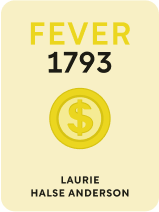

This article is an excerpt from the Shortform book guide to "Fever 1793" by Laurie Halse Anderson. Shortform has the world's best summaries and analyses of books you should be reading.
Like this article? Sign up for a free trial here .
Who is Nathaniel Benson in Fever 1793? How does Nathaniel and Matilda’s relationship grow throughout the book?
In Fever 1793, Matilda and Nathaniel Benson’s relationship grows slowly throughout the book. What started as a childhood friendship grew into more as the two got older. Then, after yellow fever subsided, the two finally came together to run the coffeehouse.
Keep reading for details about Matilda and Nathaniel Benson’s relationship in Fever 1793.
Matilda Cook and Nathaniel Benson
At the market, Matilda wandered the stalls. West Indian women sold stew from pepper pots. Chickens and hens filled the air with squawks. People bartered with shopkeepers, and children played all around. At the egg stand, Mrs. Elpers, a German farm woman, said the fever was a punishment from God for those who didn’t attend church. If you went to church, she said, you had nothing to fear.
Matilda finished her shopping and was about to leave when someone grabbed her basket from behind. When she turned to see who it was, she gasped. Nathaniel Benson stood before her, more manly and taller than she’d remembered. Her insides quivered, and she tried not to stare, but his chestnut hair was so beautiful.
Nathaniel and Matilda had known each other since they were babies. He worked as an apprentice for the famous painter Charles Peale. He also thought going to Paris sounded like a great idea. He often walked by the coffeehouse, and Matilda often walked by the Peale’s house. But they rarely spoke to each other. Lucille didn’t approve of Nathaniel. She thought he was a deadbeat or worse.
Nathaniel was going fishing and asked Matilda to join him. Despite her mother’s warnings, she was tempted. She hadn’t done anything recreational since Polly’s death. Plus, unlike with her mother, she could be herself with Nathaniel. She could even roll her shirt sleeves above her elbows. But when he smiled at her, Matilda figured she better leave her sleeves down. You had to be careful with boys and elbows. She decided she would fish like a proper lady.
Their conversation was cut short by the sound of church bells ringing. It was an odd sound because it wasn’t the top of the hour. A man nearby said the bells rang every time another person died now—one gong for each year of life. Matilda and Nathaniel listened. The bells rang twenty-one times. Matilda grew emotional, thinking about her dead friend. Nathaniel touched her shoulder to comfort her. After the bells, Matilda decided to return home. She said goodbye and walked away. She could still feel Nathaniel’s warm hand on her body.
Matilda Returns to Philadelphia
Later in the story, Eliza and Matilda took Nell to the orphanage. A desperate woman surrounded by screaming children answered the door. She said they were full to the brim with children and hardly had any room left. If the women could find another home for Nell, it would be best. At that, Eliza and Matilda agreed to take Nell home. Matilda was overjoyed. Turns out she needed Nell’s love as much as Nell needed hers.
On their way back to Eliza’s, they walked past two houses they recognized. One was the Ogilvie house. Eliza told Matilda that the family had moved to Delaware to stay with relatives. The sick daughter, Colette, had recovered, but during the fever, it came out that she’d eloped with her French tutor. The family went into an uproar, more concerned about the damage to their status than the fever. Matilda couldn’t stop laughing.
The next house got their attention because daisies were falling from the sky. When Matilda looked up, she saw that someone was throwing them out a second-story window. She realized the house belonged to Mr. Peale. Eliza rushed them forward, but Matilda was thrilled that Nathaniel was alive and still giving her flowers.
Nathaniel Benson and the Coffeehouse
The city seemed to be thriving even more than before the fever. Every day brought hundreds more back from the country. They were all fat and happy, and they were eager to carouse like nothing had happened. Matilda resented their lack of awareness of the hardships and death the people who’d stayed had endured. The ones left behind were still thin and ghostly, forever changed by the epidemic.
There was still no news from Lucille, but Matilda continued to hang on to hope. Nathaniel was there to help her. After that first day back at the market, Nathaniel came by the coffeehouse daily. He stopped by around sundown, just when Matilda was finishing cleaning up for the day and putting the children to bed. At first, their walks were short ones around the block. Then, they started to venture farther out, often ending up at the square where Grandpa was buried. The mounds were now flat, and grass had sprouted through the dirt. Matilda thought Grandpa would be happy to be somewhere crowded.
To celebrate their health and survival, Eliza suggested a thanksgiving feast. Mother Smith, Joseph, and Nathaniel joined Eliza, Matilda, and children at the coffeehouse. Before they ate, Mother Smith blessed the food. She thanked God for their good fortune and asked that he watch over those he took. Joseph said a special prayer for his wife. The fever was gone, but his grief was far from over.
The Relationship Grows
Three days after opening the coffeehouse, the place was packed. Familiar sounds and aromas filled the air. Matilda had taken to handing out free samples. She learned that people could never have just one bite of something. They inevitably ordered more to eat, and they were selling food almost faster than Eliza could make it.
Nathaniel was a regular fixture at the coffeehouse. He helped run errands, and he’d hung some of his paintings on the walls to brighten the place. He’d sold two already.
Matilda had more big plans for the shop. When they could afford it, she would buy the lot next door and expand. She also wanted to send sample cakes to the state house to generate high-profile business. Everything was going great. The coffeehouse was thriving. Her relationship with Nathaniel grew stronger each day. And she had Eliza and the children. But she was empty inside. The fever had stained her life. Grandpa and her mother were gone, and the ghosts of the fever days gripped her heart. Still, she was alive.
Lucille’s Acceptance
Matilda ran to Lucille and enveloped her in a long embrace. Lucille was light as a feather. She introduced Mrs. Ludington to Matilda and seemed to struggle to get the words out. Nathaniel stepped forward and greeted Lucille with respect. He suggested they get her inside, where she could sit and rest. Lucille agreed. Matilda waited for her mother’s disapproval of Nathaniel, but it never came.

———End of Preview———
Like what you just read? Read the rest of the world's best book summary and analysis of Laurie Halse Anderson's "Fever 1793" at Shortform .
Here's what you'll find in our full Fever 1793 summary :
- What the yellow fever epidemic in 1793 in Philadelphia looked like
- How this epidemic exposed the vulnerability of everyone, including the wealthy
- How an epidemic can impact a young person






